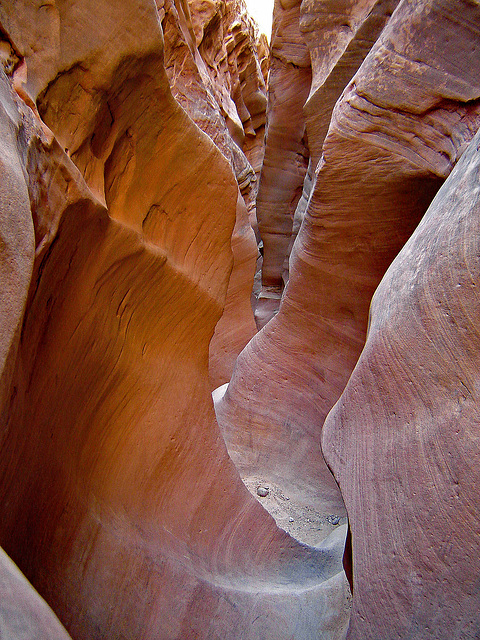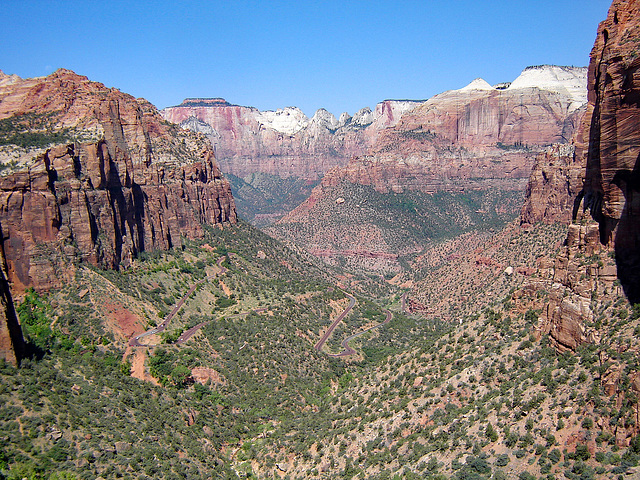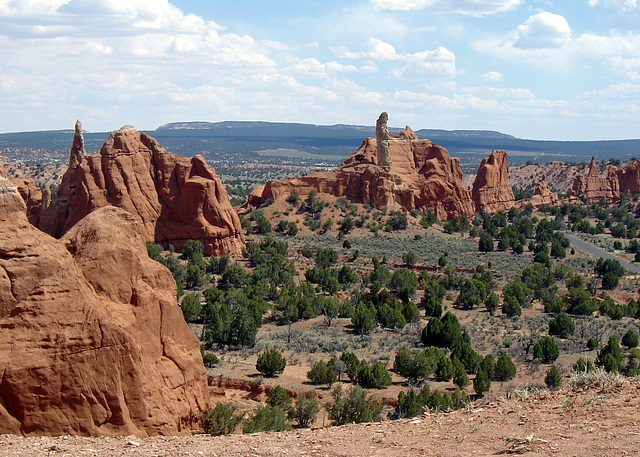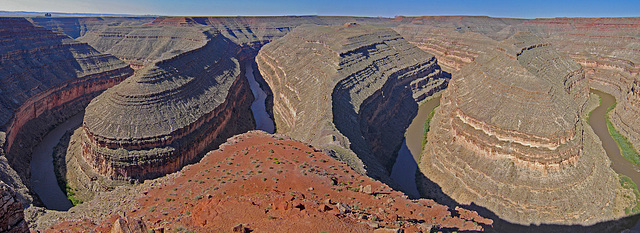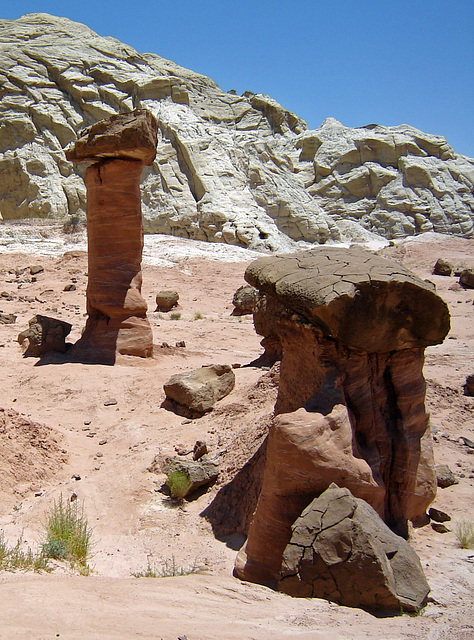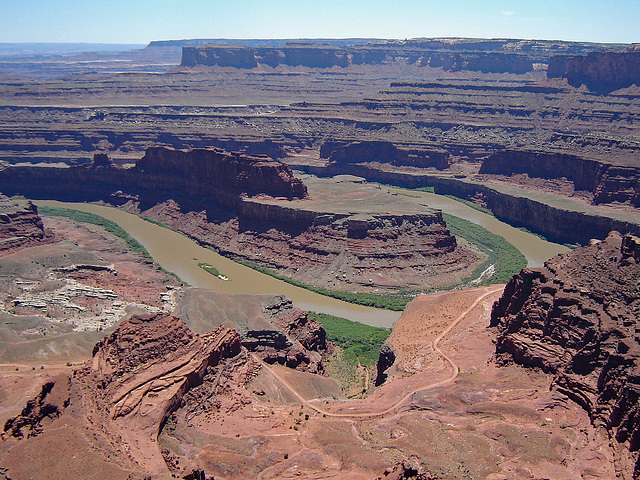
Arizona and Utah
USA - Utah, Little Wild Horse Canyon
The rocky landscape of southwest America features many ravines; a remarkable form is the slot canyon.
A slotcanyon is a gap with high vertical walls, which are very close to each other. Most slot canyons can be found in dry areas, where occasional heavy flooding occurs. During such natural disasters, the water with stone and other debris rubs through the softer rock layers, creating the narrow gorges. Little Wild Horse Canyon is considered being one of the most beautiful slot canyons in the south of Utah.
Little Wild Horse Canyon was our first slot canyon, so we were quite impressed by its beauty and diversity. Sometimes with very narrow passages where we only just could walk straight on, but there were also wider stretches with trees and shrubs. Especially in the beginning of the canyon the walls were hanging over and some alcoves were created. We regularly came across small boulders that we had to climb over. Our walk was an experience we would not have liked to miss.
USA - Mexican Hat, Valley of the Gods
The landscape of Valley of the Gods - located just north of Mexican Hat - is a scenice backcountry area, which is more or less similar to that of the much more famous Monument Valley, which lies about 30 miles to the south. Valley of the Gods is also home to magnificent buttes and towering pinnacles scattered in an empty and vast desert landscape.
The sandstone valley is accessed - free admission - by a 17 mile long dirt road. During our visit the road was very easy to ride in the beginning, but at the end were some rocky parts. Unlike Monument Valley we didn’t see almost no other tourists.
Main picture: Valley of the Gods seen from the Moki Dugway
PiP’s: panorama and rock formations of Valley of the Gods
USA - Utah, Zion National Park
Zion National Park is Utah’s first national park, which is located the small town of Springdale. With millions of visitors it is the most visited park in Utah. Zion has an area of almost 600 km² and it consists of a number of high plateaus that are intersected by deep canyons. Zion NP is located at the junction of the Colorado Plateau, Great Basin, and Mojave Desert regions.
The most important part is Zion Canyon. That is a gorge - 24 kilometers long and 800 meters deep - with high rising walls and slopes. The canyon walls are reddish and tan-coloured sandstone. The gorge has been carved out by the North Fork Virgin River and thanks to the river the canyon has a richly varied flora and fauna with numerous plant and bird species, as well as many different mammals and reptiles. In spring, when the snow in the mountains melts, the Virgin River drains large amounts of debris and sediment. As a result the erosion is still in full swing.
In 1909 the area was named “Mukuntuweap National Monument” in order to protect the canyon, which nine year later became Zion National Monument; Zion being a term used by the Mormons, who were living in the area. In November 1919 the monument was redesignated as “Zion National Park”.
Main picture : View from Canyon Overlook into the Pine Creek Canyon
PiP1 : Checkerboard Mesa along the Zion - Mount Carmel Highway
PiP2 and 3 : Zion Canyon near the Zion Lodge
USA - Utah, Kodachrome Basin State Park
In 1948 National Geographic explored the region and published some photographs in their edition of September 1949. The area was named “Kodachrome Flat”, after the relatively new brand of Kodak film they had used. In 1962 the state of Utah recognized the area as a state park, albeit under the name “Chimney Rock State Park”, for fear of repercussions from Kodak. A few years later the park was named “Kodachrome Basin State Park”, with the permission of the Kodak Film Corporation.
Kodachrome Basin State Park features a unique landscape with 67 towering monolithic rock spires or chimneys. These sand pipes, or chimney rocks, are believed to be remnants of solidified sediment that filled the ancient geysers that dominated the landscape. Red, brown, white and yellow layers of sediment became exposed as outer layers of Entrada sandstone eroded. Today, these multi-coloured sand pipes range in height from a couple of meters till more than fifty meters (the largest spire is the so called Chimney Rock).
Kodachrome Basin State Park opened to the public as a state park in 1963.
USA - Mexican Hat, Goosenecks State Park
Goosenecks State Park lies northwest of Mexican Hat, where the San Juan River flows through a couple of bends in a deep canyon. The landscape is similar to the Horseshoe Bend (Page - Arizona), although personally I found Goosenecks more impressive because it has more bends. For visitors Goosenecks State Park is ‘only’ a viewpoint for spectacular views over the river. There are no trails and/or access to the river.
The San Juan River meanders – about 300 meters below the viewpoint - through the landscape in a number of large bends, covering a linear distance of about 2 kilometers, but the real distance is no less than 9 kilometres. The bends are popularly called “goosenecks”. Goosenecks is considered being one of the most striking examples of a river meander on the North American continent.
Various geological activity have contributed to the creation of this landscape. About 300 million years ago, the rock was pushed up by movements in the earth's crust. In addition, folds in the earth caused the river to carve out the enormous bends. Water, wind and frost erosion further shaped the landscape.
(For this panorama I had to stitch a couple of images together.)
USA - Utah, Coral Pink Sand Dunes State Park
Coral Pink Sand Dunes State Park is situated at an altitude of 1,800 metres; the dune field is 14 km² large. It became the status of a state park in 1963.
The (more or less) coral pink coloured sand of the dune field consists of grains of sand, which - as a result of erosion – come from Navajo Sandstone of the Moquith and the Moccasin Mountains. The strong wind, which is characteristic for this area, finds its way through the narrow opening between the two mountain ranges. The tunnel effect ensures that the speed of the wind is increased to the point where grains of sand can be carried along (this phenomenon is called venturi affect ). After the wind has passed through the notch and reaches an open valley, its power decreases considerably, causing the sand to be deposited.
The Coral Pink Sand Dunes are estimated at 10.000 to 15.000 years old. They are not very high, the highest are about 12 meters. The area has relatively much rainfall. This is why there is plenty of vegetation present on and around the sand dunes, which is quite amazing to see. The dunes and hills of sand can move as much as almost 20 meters a year.
USA - Utah, Paria Rimrocks
Paria Rimrocks are part of Grand Staircase-Escalante National Monument. It is a quite unknown area of fantastic rock formations just north of US 89, nearby the crossing of the Paria River. The Paria Rimrocks are easy accessible through a short trail.
The area has an scenery based on bands of rock in many different colours; yellow, purple and red are the most prominent. In the rimrocks the layers are mostly white and red-brown. The differing hardness of the strata have created a great expanse of cliffs, plateaus, canyons, washes and badlands. The more unusual feature of the rimrocks is the many balanced boulders, known variously as hoodoos, goblins, toadstools or mushrooms, where flat blocks of hard sandstone are perched atop narrow columns of softer rock.
USA - Utah, Wire Pass Slot Canyon
Wire Pass Slot Canyon starts at a parking lot, accessible from US 89 though a 13 km’s long quite bumpy dirt road. The first km’s the trail is following the meandering Coyote Wash with low red coloured rocks of Navajo Sandstone. Slowly but surely the rocks become higher and closer to each other. Before we did realize we were in the Wire Pass Slot Canyon, a very impressive slot canyon. Sometimes just one meter wide and a couple of times we saw tree trunks which were trapped between the rock walls. At one point we could hardly get any further through a large boulder that almost blocked the trail.
After about 700 meters the canyon became wider and culminated in a large open space (main image) with huge rock walls, which on one side were beautifully illuminated by the sun. The cliffs are marked with several big horn sheep petroglyphs.
The Wire Pass Slot Canyon ends here at the confluence with the Buckskin Gulch, the longest slot canyon of the USA.
USA - Utah, Dead Horse Point State Park
Dead Horse Point State Park is a small, yet one of Utah’s most spectacular state parks. It is best known for its magnificent views of the Colorado River, which finds its way more than 600 meters beneath the lookout around a rocky plateau with one large gooseneck. Further away lies the fascinating landscape of Canyonlands NP with vertical pinnacles and buttes. Millions of years of geologic activity created this spectacular area. Deposition of sediments by ancient oceans, freshwater lakes, streams and wind blown sand dunes created the rock layers of canyon country.
The state park owes its name from an old story.
In one place is the rocky plateau less than 30 meters wide, so the part further away as a kind of peninsula. In the past wild horses were driven to this point by cowboys, after which the narrow neck of the land was fenced off. The best horses were tamed, the other horses were usually released. According to an old legend, it happened once that the horses trapped on the rocky plateau were left to their fate; the animals died because of a lack of water.
Jump to top
RSS feed- Latest items - Subscribe to the latest items added to this album
- ipernity © 2007-2024
- Help & Contact
|
Club news
|
About ipernity
|
History |
ipernity Club & Prices |
Guide of good conduct
Donate | Group guidelines | Privacy policy | Terms of use | Statutes | In memoria -
Facebook
Twitter

